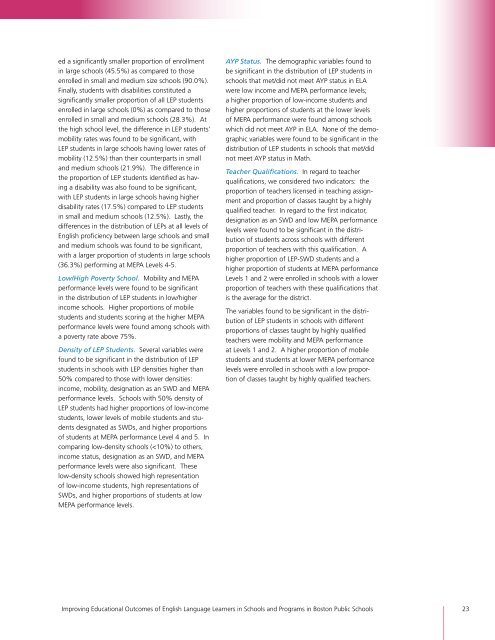Full Report - Center for Collaborative Education
Full Report - Center for Collaborative Education
Full Report - Center for Collaborative Education
Create successful ePaper yourself
Turn your PDF publications into a flip-book with our unique Google optimized e-Paper software.
ed a significantly smaller proportion of enrollment<br />
in large schools (45.5%) as compared to those<br />
enrolled in small and medium size schools (90.0%).<br />
Finally, students with disabilities constituted a<br />
significantly smaller proportion of all LEP students<br />
enrolled in large schools (0%) as compared to those<br />
enrolled in small and medium schools (28.3%). At<br />
the high school level, the difference in LEP students’<br />
mobility rates was found to be significant, with<br />
LEP students in large schools having lower rates of<br />
mobility (12.5%) than their counterparts in small<br />
and medium schools (21.9%). The difference in<br />
the proportion of LEP students identified as having<br />
a disability was also found to be significant,<br />
with LEP students in large schools having higher<br />
disability rates (17.5%) compared to LEP students<br />
in small and medium schools (12.5%). Lastly, the<br />
differences in the distribution of LEPs at all levels of<br />
English proficiency between large schools and small<br />
and medium schools was found to be significant,<br />
with a larger proportion of students in large schools<br />
(36.3%) per<strong>for</strong>ming at MEPA Levels 4-5.<br />
Low/High Poverty School. Mobility and MEPA<br />
per<strong>for</strong>mance levels were found to be significant<br />
in the distribution of LEP students in low/higher<br />
income schools. Higher proportions of mobile<br />
students and students scoring at the higher MEPA<br />
per<strong>for</strong>mance levels were found among schools with<br />
a poverty rate above 75%.<br />
Density of LEP Students. Several variables were<br />
found to be significant in the distribution of LEP<br />
students in schools with LEP densities higher than<br />
50% compared to those with lower densities:<br />
income, mobility, designation as an SWD and MEPA<br />
per<strong>for</strong>mance levels. Schools with 50% density of<br />
LEP students had higher proportions of low-income<br />
students, lower levels of mobile students and students<br />
designated as SWDs, and higher proportions<br />
of students at MEPA per<strong>for</strong>mance Level 4 and 5. In<br />
comparing low-density schools (


